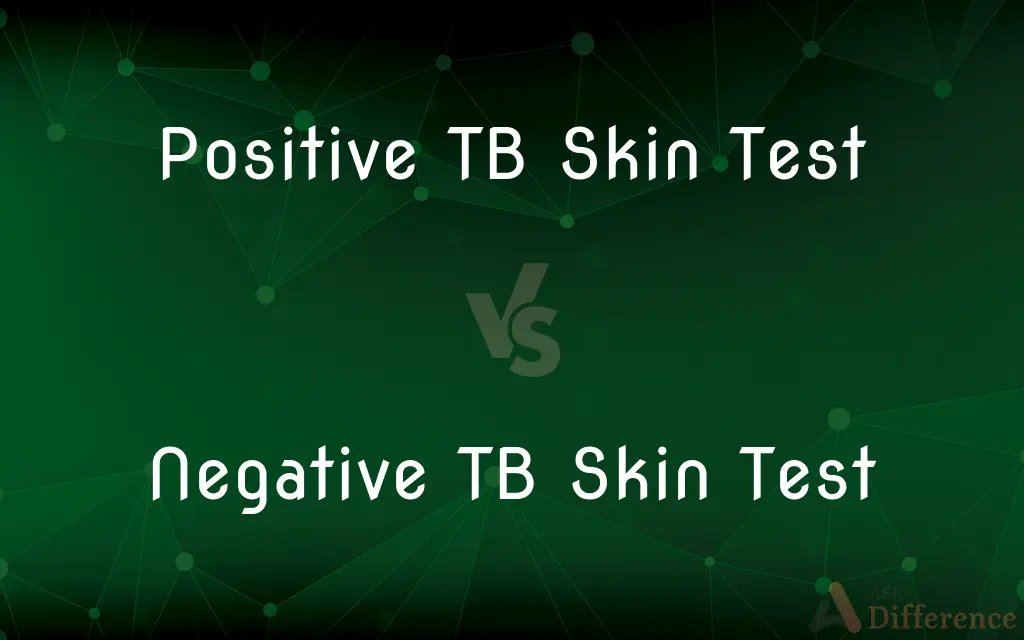Positive TB Skin Test vs. Negative TB Skin Test — What's the Difference?
By Tayyaba Rehman — Published on January 24, 2024
A positive TB skin test indicates a likely exposure to tuberculosis, showing an immune response, whereas a negative test suggests no detectable TB infection.

Difference Between Positive TB Skin Test and Negative TB Skin Test
Table of Contents
ADVERTISEMENT
Key Differences
Response to Tuberculin: In a positive TB skin test, the skin reacts to tuberculin (a purified protein derivative) injected under the skin, indicating possible TB exposure. A negative TB skin test shows no significant reaction, suggesting no TB exposure.
Indication of Infection: A positive test does not confirm active TB but suggests a prior or latent TB infection. A negative test generally indicates the absence of TB infection, but doesn't rule out recent exposure.
Further Testing: After a positive TB skin test, additional tests like chest X-rays are needed to determine if the infection is active. A negative test usually requires no further TB-specific tests unless there are symptoms or recent exposure.
Impact on Public Health Measures: A positive result may lead to public health interventions, such as contact tracing and treatment for latent TB. Negative results typically do not require public health actions.
Consideration of Risk Factors: In individuals with high TB risk, a positive test is more significant and prompts immediate action. A negative test in low-risk individuals is more conclusive for ruling out TB.
ADVERTISEMENT
Comparison Chart
Skin Reaction
Visible reaction (raised bump) to tuberculin
No significant reaction to tuberculin
Indication
Possible prior or latent TB infection
Generally indicates no TB infection
Further Testing
Requires additional testing (e.g., chest X-ray)
Typically no further TB-specific tests needed
Public Health Action
May lead to contact tracing, treatment
Usually no public health actions required
Significance in Risk Groups
More significant in high-risk individuals
More conclusive in low-risk individuals
Compare with Definitions
Positive TB Skin Test
An indication for further TB diagnostic evaluations.
After the positive TB skin test, he was referred for additional tests.
Negative TB Skin Test
Suggestive of no current TB exposure.
The negative TB skin test was reassuring to the healthcare workers.
Positive TB Skin Test
A result requiring public health follow-up in certain cases.
The clinic conducted contact tracing after his positive TB skin test.
Negative TB Skin Test
More conclusive in individuals with low risk of TB.
In low-risk areas, a negative TB skin test usually rules out TB.
Positive TB Skin Test
A reaction to a TB skin test indicating possible TB exposure.
Her positive TB skin test led to a follow-up chest X-ray.
Negative TB Skin Test
No indication of immune response to TB bacteria.
A negative TB skin test meant she hadn't been exposed to TB.
Positive TB Skin Test
A trigger for considering latent TB infection treatment.
Her doctor recommended treatment for latent TB following her positive skin test.
Negative TB Skin Test
A result showing no significant reaction to the TB skin test.
His negative TB skin test indicated no detectable TB infection.
Positive TB Skin Test
A sign of immune response to tuberculosis bacteria.
The positive TB skin test suggested he had been exposed to TB at some point.
Negative TB Skin Test
Often no further action needed unless there's high risk or symptoms.
Despite her symptoms, her negative TB skin test meant further tests were needed.
Common Curiosities
Is a negative TB skin test always accurate?
It's reliable, but recent exposure or weakened immune system can affect results.
Can a positive TB skin test mean active TB?
Not necessarily; it requires further investigation.
What happens after a positive TB skin test?
Additional tests like a chest X-ray or sputum test are needed.
What does a positive TB skin test indicate?
Possible exposure to TB, but not necessarily active disease.
What does a negative TB skin test mean?
Generally, no detectable TB infection.
Can someone with a BCG vaccine have a positive TB skin test?
Yes, the BCG vaccine can cause a false positive.
What factors affect a negative TB skin test?
Recent exposure, incorrect test administration, or a weakened immune system.
How long after exposure does a TB skin test turn positive?
It can take 2-10 weeks after exposure for a positive reaction.
Can a person with latent TB have a positive skin test?
Yes, latent TB often causes a positive skin test.
Does a positive TB skin test mean isolation?
Not unless active TB is diagnosed.
Can a negative TB skin test turn positive later?
Yes, especially if there's subsequent exposure to TB.
How often should high-risk individuals get a TB skin test?
Annually, or as recommended by healthcare providers.
Can both tests be used for TB screening in all age groups?
Yes, but interpretation may vary based on age and risk factors.
Are there side effects to the TB skin test?
Minor side effects like redness or swelling at the injection site are possible.
What's the difference in handling positive vs. negative TB skin tests?
Positive tests require follow-up and possibly treatment, while negative usually do not.
Share Your Discovery

Previous Comparison
Nutramigen vs. Alimentum
Next Comparison
Bratwurst vs. Italian SausageAuthor Spotlight
Written by
Tayyaba RehmanTayyaba Rehman is a distinguished writer, currently serving as a primary contributor to askdifference.com. As a researcher in semantics and etymology, Tayyaba's passion for the complexity of languages and their distinctions has found a perfect home on the platform. Tayyaba delves into the intricacies of language, distinguishing between commonly confused words and phrases, thereby providing clarity for readers worldwide.
















































